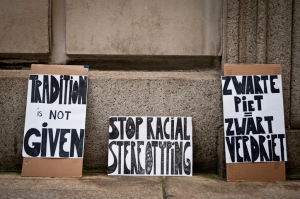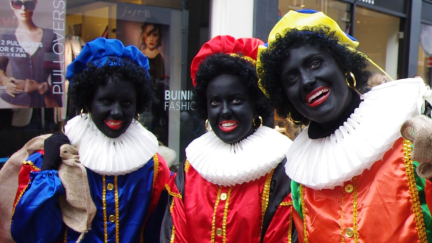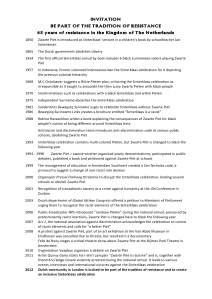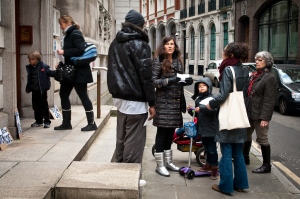News
Blackface in London: What do Dutch expats think of Zwarte Piet?
(December 06, 2012)Blackface in London: What do Dutch expats think of Zwarte Piet?
By Mez Ghide and Kaya Völke
This blog post is an add-on to the recent article “Like the Golliwog, Zwarte Piet is a racist relic, so why is it part of the modern Dutch Christmas?” posted in The Independent on the 28th of November regarding the Dutch Sinterklaas (Saint Nicholas) celebration.
The annual Sinterklaas celebration is a public event many Dutch people consider to be the best national celebration of the year. In light of this, members of the Dutch diaspora organised small festivities in the Dutch Church in East London. This included the controversial figure of Zwarte Piet, who would appear in blackface as advertised on the Verening Neerlandia’s website. The program for the day included singing, activities for the children, the Sinterklaas’ arrival and Zwarte Piet handing out presents.
Following the publication of the article, we decided to stage a small demonstration at the Dutch Church by putting down placards and handing out leaflets giving a general overview of the resistance against Zwarte Piet’s racist elements in the Kingdom of The Netherlands. The aim of the protest was to raise awareness of the ongoing discussions in The Netherlands and the UK against racist imagery and to invite the Dutch community in London to become part of this resistance.
The Vereniging Neerlandia, an organisation that aims to accommodate the needs of Dutch people living in the UK, i.e. “to meet other Dutch people, speak Dutch and exchange experience”, organises various events, amongst which is a Sinterklaas celebration, held at the Dutch Church on Saturday. Located on one of the winding streets just off Bishopsgate, a few blocks from Bank tube station, the street was mostly empty. Besides a few security guards with walkie-talkies at nearby office buildings and a local walking group, we were the only ones there.
- Zwarte Pieten in Amsterdam, The Netherlands
- Zwarte Piet in London, UK
A man came out of the church and greeted us. We talked to him and he confirmed that there will indeed be a Sinterklaas celebration with blackface Zwarte Pieten. We invited him to become part of the resistance against racist imagery, which he thanked us for and he then told us what door would be opened to welcome the guests.
The church doors opened at 1pm and we welcomed guests until 2pm. Some were very receptive and expressed being unable to reason about this with other Dutch people. For instance, a white woman who said her partner is black and who came with her family to the event spoke about her unease with the Zwarte Piet characters’ potential to negatively affect her children’s understandings of race. Her negotiation of the situation was not to deny them the experience of the Sinterklaas celebration, but to offset this potential with positive role models within the family. Although her attitude towards our presence was more open, her position that the individual family can transform negative stereotypes that are founded on a nationwide scale mistakenly assumes that societal issues of racism can be managed or even solved on a micro-level. This way of thinking also underestimates the need for radical change to breach the Dutch majority’s default acceptance of racist imagery.
From this point onwards however, it went downhill as the other visitors’ thoughts on the matter started to draw from the same tradition of denial that has been used to dodge the resistance against Zwarte Piet in The Netherlands for decades. The following are just samples of the various responses:
- A Dutch white man visiting London immediately responded to our leaflets with the stance that Zwarte Piet was not introduced to the Dutch public sphere as a servant. Having been pointed to the lyrics and title of the popular Sinterklaas song title, “Sinterklaasje kom maar binnen met je knecht” (Sinterklaas come on in with your servant), he quickly changed strategies to claim that “Zwarte Piet is just a symbol”.
- An elderly Dutch white man claimed that in his life “the majority of African immigrants living in Southeast Amsterdam” enjoyed the Zwarte Piet figure without objections.
- A London-based Australian man married to a Dutch woman dismissed our purpose on the grounds that it did not include elves and Sinterklaas because they are also caricatures namely of little people and white men respectively.

Honouring a long tradition of resistance, placards included slogans from previous protests in The Netherlands. “Zwarte Piet = zwarte verdriet” (Black Pete = black grief) refers to the protest movement in the 90s that staged various demonstrations, participated in debates and published a book critically analysing the Zwarte Piet figure. Participants of the movement faced verbal and physical abuse and received threats. “Tradition is not given” refers to an 2008 art exhibition that included a performance art protest march. Unfortunately, the march did not take place due to death threats to the organisers.
To summarise, these denials portray the all too familiar ways by which the movement to eliminate the racist imagery in the celebration is rendered invalid, i.e. an ahistoricized understanding of Zwarte Piet’s conception and role, claiming representative power to justify the existence of racist symbols by providing experiential and regional snapshots and the deflection of the purpose by accusing the movement in itself of being exclusionary as if the liberation goals outside the project at hand are met by the speaker.
By far the most interesting visitor, however, was a young black man with Dutch and Nigerian parents who explained to us that he has been performing the role of Zwarte Piet at this event since he was a little boy. Prior to meeting him, his mother asked for two leaflets so she could pass one on to her son and informed us that he would arrive shortly to perform the role in blackface. The mother did think it was important to have a discussion, but upon his arrival another participant remarked that the presence of a black Zwarte Piet made our protest illegitimate. However, he expressed an initial agreement with the movement and he was eager to learn more about our point of view and we exchanged numbers.
All in all, we saw what we expected and it reinforced our position that more discussion is needed around this issue. Furthermore, the fact that this event took place outside The Netherlands in a Britain that is still contesting Enid Blyton’s Golliwog did not explicitly show that an outside scrutiny altered the views held by Dutch expatriates.




